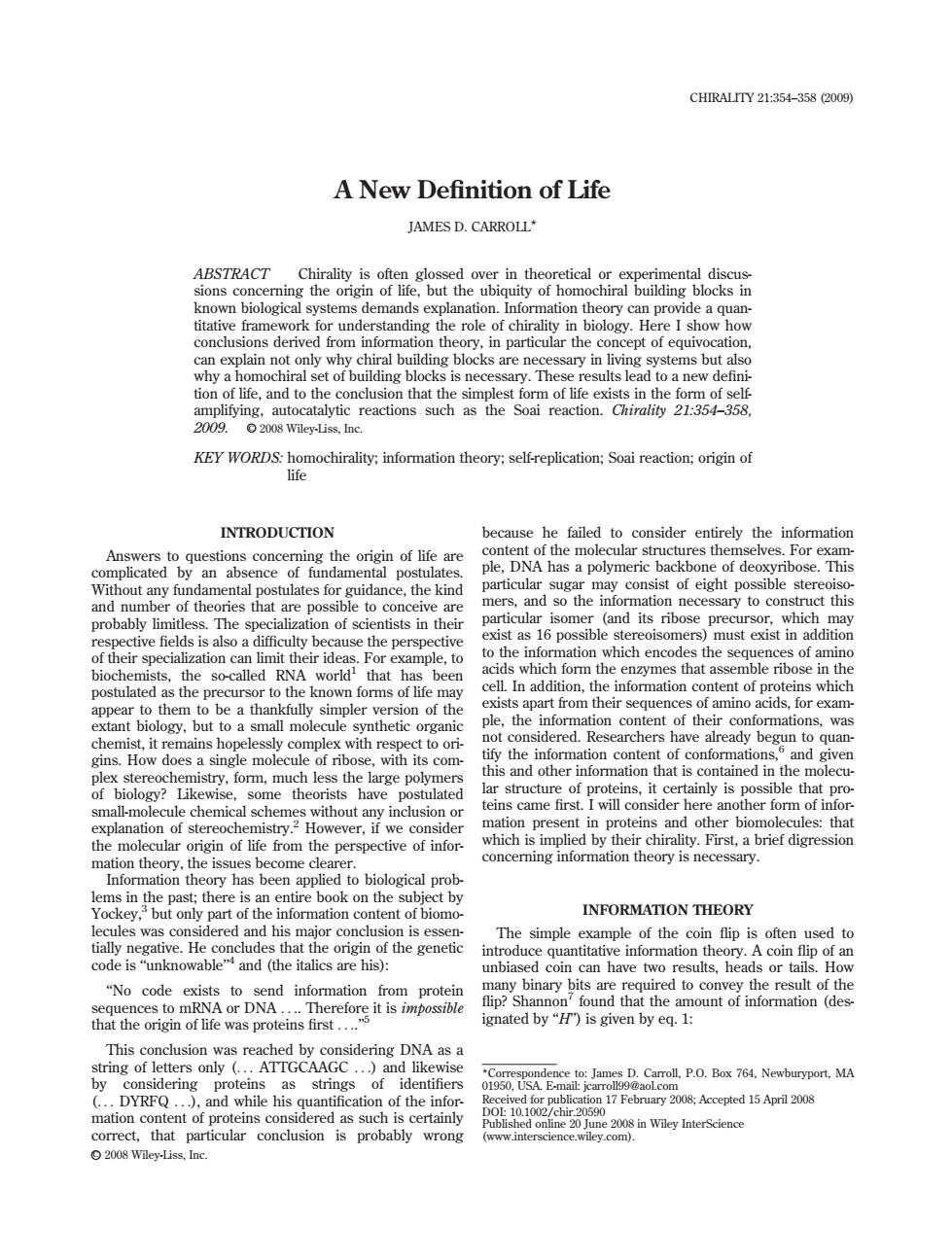正在加载图片...

CHIRA1TY21354-3582009 A New Definition of Life JAMES D.CARROLL* ooceming theof e but the b of homochrabuing conclu ons derive info ept of equi 1. to newdefin 2009.02008Wwe-s.nc KEY WORDS mochirality.information theory:self-replication;Soai reaction:origin of INTRODUCTION because he entirely of deo se.This ostulates fo the kind mers,and so the infor ation nece sary to construct thi e the perspec that h been ors of cell In addition.th teins which 品a of the thetic organi the ation content of their nations.was esearchers have already with its com y the egg his and other information that is c ntained in the molecu the of life from the perspective of infr whin pres concerning information theory is necessary. INFORMATION THEORY The simple example of the coin flip is often used to d infor %binary bi ignated by)is given by This conclusion was reached by considering DNA as a 10A i DYRFQ and while his of the correct,that particular conclusion is probably wrong 2008 Wiley-Liss.Inc. A New Definition of Life JAMES D. CARROLL* ABSTRACT Chirality is often glossed over in theoretical or experimental discussions concerning the origin of life, but the ubiquity of homochiral building blocks in known biological systems demands explanation. Information theory can provide a quantitative framework for understanding the role of chirality in biology. Here I show how conclusions derived from information theory, in particular the concept of equivocation, can explain not only why chiral building blocks are necessary in living systems but also why a homochiral set of building blocks is necessary. These results lead to a new definition of life, and to the conclusion that the simplest form of life exists in the form of selfamplifying, autocatalytic reactions such as the Soai reaction. Chirality 21:354–358, 2009. VC 2008 Wiley-Liss, Inc. KEY WORDS: homochirality; information theory; self-replication; Soai reaction; origin of life INTRODUCTION Answers to questions concerning the origin of life are complicated by an absence of fundamental postulates. Without any fundamental postulates for guidance, the kind and number of theories that are possible to conceive are probably limitless. The specialization of scientists in their respective fields is also a difficulty because the perspective of their specialization can limit their ideas. For example, to biochemists, the so-called RNA world1 that has been postulated as the precursor to the known forms of life may appear to them to be a thankfully simpler version of the extant biology, but to a small molecule synthetic organic chemist, it remains hopelessly complex with respect to origins. How does a single molecule of ribose, with its complex stereochemistry, form, much less the large polymers of biology? Likewise, some theorists have postulated small-molecule chemical schemes without any inclusion or explanation of stereochemistry.2 However, if we consider the molecular origin of life from the perspective of information theory, the issues become clearer. Information theory has been applied to biological problems in the past; there is an entire book on the subject by Yockey,3 but only part of the information content of biomolecules was considered and his major conclusion is essentially negative. He concludes that the origin of the genetic code is ‘‘unknowable’’4 and (the italics are his): ‘‘No code exists to send information from protein sequences to mRNA or DNA .... Therefore it is impossible that the origin of life was proteins first ....’’5 This conclusion was reached by considering DNA as a string of letters only (... ATTGCAAGC ...) and likewise by considering proteins as strings of identifiers (... DYRFQ ...), and while his quantification of the information content of proteins considered as such is certainly correct, that particular conclusion is probably wrong because he failed to consider entirely the information content of the molecular structures themselves. For example, DNA has a polymeric backbone of deoxyribose. This particular sugar may consist of eight possible stereoisomers, and so the information necessary to construct this particular isomer (and its ribose precursor, which may exist as 16 possible stereoisomers) must exist in addition to the information which encodes the sequences of amino acids which form the enzymes that assemble ribose in the cell. In addition, the information content of proteins which exists apart from their sequences of amino acids, for example, the information content of their conformations, was not considered. Researchers have already begun to quantify the information content of conformations,6 and given this and other information that is contained in the molecular structure of proteins, it certainly is possible that proteins came first. I will consider here another form of information present in proteins and other biomolecules: that which is implied by their chirality. First, a brief digression concerning information theory is necessary. INFORMATION THEORY The simple example of the coin flip is often used to introduce quantitative information theory. A coin flip of an unbiased coin can have two results, heads or tails. How many binary bits are required to convey the result of the flip? Shannon7 found that the amount of information (designated by ‘‘H’’) is given by eq. 1: *Correspondence to: James D. Carroll, P.O. Box 764, Newburyport, MA 01950, USA. E-mail: jcarroll99@aol.com Received for publication 17 February 2008; Accepted 15 April 2008 DOI: 10.1002/chir.20590 Published online 20 June 2008 in Wiley InterScience (www.interscience.wiley.com). CHIRALITY 21:354–358 (2009) VC 2008 Wiley-Liss, Inc